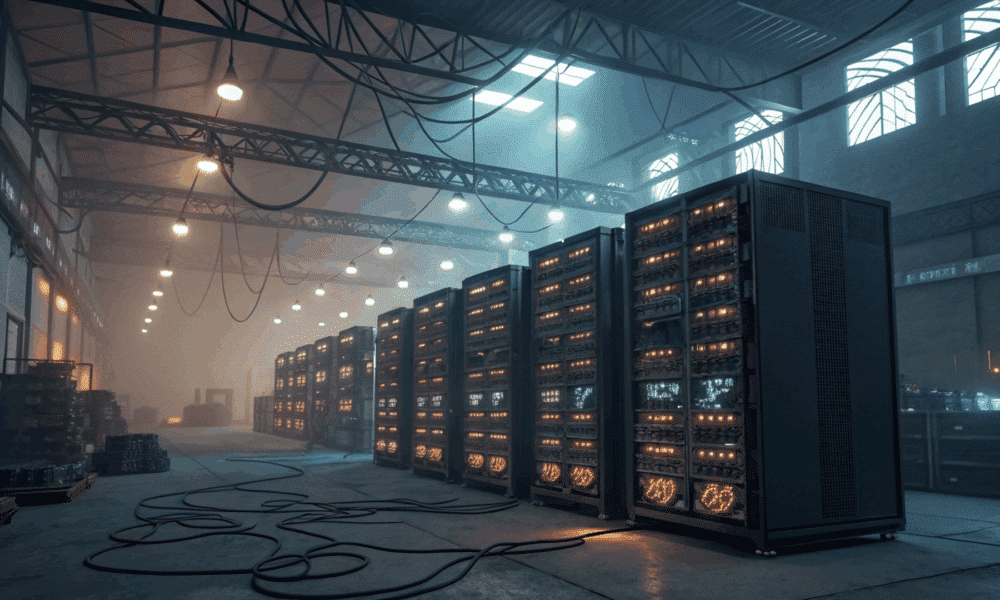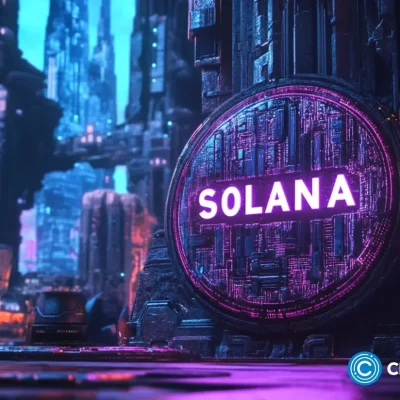Let’s be real. Bitcoin isn’t just magic internet money appearing out of thin air. It needs muscle. Serious, industrial-grade muscle. That muscle comes from “Bitcoin Farms.”
Picture warehouses, not basements, stuffed with thousands of specialized computers screaming away day and night. These places are Bitcoin’s engine room. They’re the ones actually processing transactions, keeping the whole network safe from scammers, and yeah, they’re how new Bitcoins get born.
How did we get from folks tinkering on home PCs to these massive operations? Blame Bitcoin’s own rulebook: Proof-of-Work (PoW). It’s designed to get harder and harder, forcing a constant battle for more computing power.
If you don’t get how these farms tick, you’re missing a huge piece of the puzzle for understanding Bitcoin’s price swings and its actual, physical footprint on the world.
So, What’s This “Mining” Thing, Really?


Bitcoin mining
Think of Bitcoin like a shared public ledger anyone can see but nobody centrally controls. Mining is how new entries get added securely. PoW is the bouncer at the door.
Miners have to prove they’ve done some serious computational heavy lifting – burning real electricity – before they’re allowed to add the next page (block) to the ledger. This “work” makes it ridiculously expensive for anyone to try and cheat the system or spend the same Bitcoin twice.
The actual job? It’s a high-speed guessing game. Miners grab a bunch of pending transactions floating around (in the “mempool”), mix them with some technical data, and add a random number called a “nonce.” They feed this combo into a cryptographic blender (SHA-256) hoping the resulting code, the hash, is below a specific target number set by the network.
It’s pure brute force – try a nonce, hash it, check it, fail, change the nonce, hash again, trillions of times a second. Before they even start this race, they’re supposed to quickly check the transactions are valid – make sure people actually own the Bitcoin they’re trying to send.
The first miner to find that lucky nonce gets to add the block. They broadcast it, everyone else checks their work, and boom, it’s part of the permanent chain.
The prize? Freshly minted Bitcoin (3.125 BTC right now, post-April 2024 halving) plus all the transaction fees people paid for speedier service. That reward is the whole reason miners bother spending all that cash on hardware and power. It keeps the lights on and the network secure.
And here’s the kicker: the difficulty adjustment. Bitcoin automatically tweaks how hard that guessing game is every couple of weeks (2,016 blocks). If miners worldwide are finding blocks too fast (say, faster than the target 10-minute average), the puzzle gets harder. Too slow? It gets easier.
This keeps the new Bitcoin supply predictable, regardless of how many machines are running. It also means the cost to mine is always shifting based on global competition, pushing miners relentlessly towards faster, leaner machines.
The Hardware Treadmill: From CPUs to ASIC Beasts


Crypto mining hardware
The gear miners use has gone through a crazy evolution, basically an arms race for raw speed and power efficiency.
- Way back in 2009-2010? Your regular computer’s brain (CPU) was enough. Early birds could actually mine stacks of BTC.
- Then, around late 2010, people realized graphics cards (GPUs), designed for video games, were way faster for Bitcoin’s math. That’s when you started seeing home-built mining rigs pop up.
- A quick detour through FPGAs (programmable chips) offered better power savings for a bit (2011-2012).
- But 2013 changed everything. Application-Specific Integrated Circuits (ASICs) hit the scene. These chips do one thing and one thing only: Bitcoin mining’s SHA-256 algorithm. And they do it orders of magnitude faster and more efficiently than anything else. GPUs? FPGAs? Obsolete overnight for BTC. ASICs cemented mining as an industrial gig. They cost a bomb, suck down electricity, need massive cooling – suddenly, you needed dedicated warehouses, often in places with cheap power. Hello, Bitcoin farms.
This arms race created the “ASIC hamster wheel.” New, slightly better chips come out constantly. Older models become unprofitable as the network gets harder and rewards drop. Miners have to keep buying the latest gear just to stay in the game. Big upfront costs, constant reinvestment – that’s the reality. And yeah, it creates a mountain of outdated, specialized e-waste with few other uses.
Big Shifts: Pool Parties, China’s Exit, and the Halving Ax
The mining world didn’t stand still. A few things really shook it up:
- Pooling resources (around 2010 onward): Finding a block solo got near impossible pretty fast. Mining pools let individuals combine their computing power. When the pool finds a block, everyone gets a slice of the reward based on their contribution. It meant smaller players could get steadier, smaller payouts instead of hoping for a lottery win. Great for participation, but it also led to worries when a couple of giant pools (like Foundry and AntPool recently) controlled huge chunks, sometimes over 51%, of the network’s hash power. That smells like centralization.
- When China pulled the plug (2021): For ages, China dominated mining. Cheap power (hydro and coal) and nearby chip makers meant maybe 65-75% of all Bitcoin mining happened there. That concentration felt risky. Then, in May 2021, the government banned it. Reasons ranged from financial control to environmental targets and promoting their own digital currency. Miners fled, triggering the “Great Mining Migration.” Hash rate plunged temporarily. Operations rushed to places like the US, Canada, Kazakhstan, and Russia. Bitcoin survived, sure, and mining spread out geographically. But the chaos also helped bigger, publicly listed North American companies consolidate even more power, since they had the resources to move and set up shop again.
- The halving – Bitcoin’s built-in pay cut: Bitcoin’s code automatically slashes the mining reward in half roughly every four years. It’s designed to control inflation and make Bitcoin scarcer over time, like digging for gold getting harder.
Table 1: Bitcoin Halving History
Event Date Block Height New Block Reward BTC Price (Approx. Pre-Halving) BTC Price (Approx. 1 Year Post-Halving) 1st Halving Nov 28, 2012 210,000 25 BTC ~$12 ~$964 – $1,003 2nd Halving Jul 9, 2016 420,000 12.5 BTC ~$583 – $663 ~$2,500 – $2,608 3rd Halving May 11, 2020 630,000 6.25 BTC ~$6,910 – $8,500 ~$55,847 (Peaked ~$69K later) 4th Halving Apr 19/20, 2024 840,000 3.125 BTC ~$64,000 TBD - Each halving is a direct hit to miners’ income. If the price doesn’t compensate, the least efficient operations simply can’t afford to run anymore and shut down. This predictable supply squeeze is a major focal point for anyone watching the market.
Following the Money: How Mining Moves Markets


Crypto mining moving markets
The economics here are tightly wound around Bitcoin’s price. Keep an eye on these:
- Hash rate & difficulty: More hash rate usually signals miners are bullish and investing, which generally makes the network more secure. Difficulty climbs to match, making it costlier to mine each coin. It’s a constant balancing act.
- Power costs: That electric bill is usually the biggest ongoing cost. Cheap power is king. It’s why farms cluster in certain regions and why there’s a big push towards renewables or even using wasted energy like flared gas from oil fields. Got to cut costs somehow. Recent search results confirm miners like Iris Energy (IREN) boast leading efficiency (around 15 J/TH) and secure low energy rates (like ~$0.032/kWh in Texas) to maximize margins, which could reach nearly 80%.
- Making money (or not): Profit = (BTC price * Your Share of Rewards) – (Power + Cooling + Staff + Hardware Costs). “Hashprice” (daily $/TH/s) is a quick gauge. If it drops below your cost, you’re losing money. After the 2024 halving, CoinShares estimated the average production cost jumped to around $37,856/BTC. Ouch!
- Miner wallets – Sell or HODL?: Miners gotta sell some BTC to pay bills. That selling can push prices down, especially after a halving when revenue just got cut. But if miners are holding onto coins, it suggests they think the price will go up, or they’re strong enough to ride out dips. Analysts watch these flows closely. Recent data (April 2025) suggests miners remain surprisingly confident despite price drops and external economic pressures, holding onto their BTC.
- The halving cycle dance: Historically, Bitcoin price tends to pump significantly in the year or so after a halving. The theory? Less new supply hitting the market meets steady or growing demand. It’s a supply shock. While miners earn less BTC per block, the price rise (if it happens) has historically saved the efficient ones. You often see a temporary dip in hash rate right after a halving as the weaklings quit, before it starts climbing again. But, as always, past performance is no guarantee.
It’s complex: Price up -> miners invest -> hash rate/difficulty up -> costs up -> profits squeezed unless price keeps going up. Halvings throw a wrench in this, chopping revenue, forcing consolidation, reducing supply, and historically kicking off the next big price move.
The Human Side: Dreams, Dust, and Drama
Don’t forget, behind the machines are people.
- You had the pioneers, the cypherpunks like Hal Finney, the guy who bought pizzas for 10,000 BTC.
- Plenty struck it rich, early miners or just HODLers who saw unbelievable gains. Some built successful businesses finding cheap power early.
- But many also lost big. Lost keys, forgotten passwords, selling way too soon. Big farm ventures have gone bankrupt. Scams and exchange hacks (remember Mt. Gox?) took their toll. It’s high risk.
- And what about the neighbors? Industrial mining farms aren’t quiet. People living nearby complain constantly about the relentless noise from cooling fans – like living next to a jet engine, 24/7. Lawsuits have been filed citing serious health issues: hearing loss, migraines, vertigo, constant stress, sleep deprivation. These farms can also strain local power grids, maybe even push up electricity rates for everyone else. Promises of local jobs often fall flat as the farms are highly automated. Plus, all those quickly outdated ASICs pile up as e-waste. There’s a real tension between these local impacts and the global network.
Where Things Are Headed: Efficiency, Energy, Regulation


The path ahead for Bitcoin farms
The future for Bitcoin farms revolves around a few key battlegrounds:
- More halvings, less reward: The next halving is expected around 2028 (reward drops to 1.5625 BTC). Eventually, the block reward will become tiny. Transaction fees will have to make up the difference to pay for security. Will they be high enough? Models like Stock-to-Flow predict crazy high prices based on scarcity, but they’re just models.
- ASIC tech – Squeezing more juice: That hamster wheel keeps spinning. Chip makers are targeting big efficiency gains – aiming for maybe 10 J/TH soon, potentially even 5 J/TH later in 2025/2026, compared to today’s best at 15-20 J/TH. These gains are essential for miners to survive future halvings. But are we hitting physical limits on how small chips can get?
- The energy question: Bitcoin’s power consumption is still a massive debate. Estimates put it near small countries. There’s a definite push towards greener energy – hydro, solar, wind, flared gas. It’s driven by cost, investor pressure (ESG), and fear of regulators. Renewables might power over half of mining already, maybe 60-75% by 2030? Emissions per unit might be falling, but if BTC price moons, total energy use could still soar.
- Governments watching: Regulators globally are struggling with mining. Concerns are energy use, grid stability, noise, e-waste, financial risks. China banned it. Some US proposals want emissions reporting. Other places welcome miners. This messy global picture means miners might just keep moving to places with fewest rules, making global standards hard to enforce. Regulation remains a huge unknown.
Wrapping Up: The Ongoing Power Struggle
So, Bitcoin mining isn’t a hobby anymore. It’s a cutthroat global industry powered by these specialized farms. They exist because of PoW’s demands, the ASIC hardware race, and the raw economics of block rewards versus crushing energy costs.
Pools, the China migration, the halvings – these events have constantly reshaped the landscape, favoring those with deep pockets and efficient operations. The health of these farms, Bitcoin’s price, network security – it’s all tangled together.
Looking ahead? It’s a tightrope walk. Miners need constant tech upgrades and cheaper, greener power to fight the pressure from future halvings. Transaction fees absolutely must grow to take over from the dwindling block rewards. And all this happens under the looming shadow of regulation.
How this power struggle between tech, economics, energy, and regulators plays out will define the next era for Bitcoin’s industrial heart.





